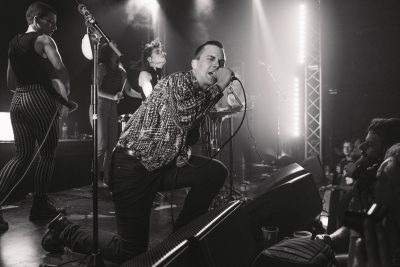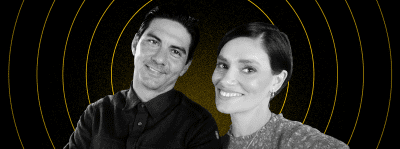Claustrophobia, Dark Fiber, and How to Dodge the NSA : Or, What I Learned at the Eyebeam Showcase
Last summer, Eyebeam, the city’s premiere arts and technology organization, became another casualty of the real estate boom in Chelsea. “We had been there for 13 years,” Peter Kaiser, Eyebeam’s Communications Director explained over the phone. “The sale of the building made a lot of sense not just financially, but also in terms of cultural shifts in the neighborhood. When Eyebeam first opened in Chelsea, it was still very much a working neighborhood.”
So it wasn’t exactly surprising when the Atlantic Foundation–an organization the Times once called “one of the world’s largest and most secretive philanthropic endowments”–sold the building on 21st street near the West Side Highway for $50 million. But the sale actually came with some great news for Eyebeam–Atlantic granted the arts organization a whopping $8 million to put toward a new space.
In light of Eybeam’s uprooting by an astronomically hot real estate market, it might seem strange that they’re having a show in Dumbo. Did they simply trade one extremely fancy neighborhood for another? Well, no. The space on Front Street where Eyebeam is hosting its 2015 Annual Showcase (organized by Roddy Schrock) is only a temporary arrangement. The site was temporarily loaned to Eyebeam for the exhibition by Two Trees, the real estate moguls who not only own pretty much all of DUMBO, but are also behind the new Domino development. Eyebeam’s semi-permanent location, for now anyway, is actually at Industry City in Sunset Park.
Last we checked, Eyebeam was planning to open their new permanent headquarters at a development in the works across from BAM known as North Site II. But as Kaiser explained, Eyebeam “pulled the plug” on that project. “We decided that we’d signed up for that plan in haste,” Kaiser admitted. “We realized that being so close to BAM, Theatre For a New Audience, BRIC Arts Center in Downtown Brooklyn, all these things would have leaned a lot of our resources toward public displays.”
Although the organization hosted a significant number of public exhibitions in Chelsea, for now Eyebeam is seeking to focus its efforts more fully on the artist residency program.
But Kaiser was careful to emphasize that Eyebeam isn’t cutting itself off from the public in any way. “One of the great things about the move [to Brooklyn] is that we are starting to collaborate with different organizations and institutions. We can really reach out to communities that normally wouldn’t know about us,” he said. “But we really want to focus a lot of our funding and efforts on the support of the projects we bring in through our residencies and fellowships.”
The 2015 Annual Showcase, then, is a sort of capstone for the various fellows and artists-in-residence at Eyebeam. It’s also a chance for the organization to show off the extensiveness of its inquiries into art and technology. Roddy Schrock is the Director of Residencies and Programs, and as he explained:
“This year’s Annual Showcase is another example of the organization’s commitment to nurturing artists who interrogate our relationship to emerging technology,” Shrock wrote in an email. “It includes meditations on historical relations to technology’s darker side, as seen through the lens of Torkwase Dyson’s architectural sculpture, as well as more playful works such as Nancy Nowacek’s digital library of all human gestures.”
During our visit to the exhibition yesterday, we ogled some seriously fascinating and at times deeply politicized art work. What we found to be the most compelling though were the works of darker focus.
One piece straight up made our jaws drop–”Seeing Networks in New York: a Field Guide to Internet Infrastructure,” by Ingrid Burrington, a 2014 resident at Eyebeam, was a precise, minimally detailed hand-drawn map accompanied by a few printed booklets. The two-part piece functions as a guide to what are effectively hidden, but not exactly secret internet, telecommunications, or surveillance infrastructural elements in and around the Chelsea neighborhood.
Most of the accompanying text and diagrams–floor plans, decoded markings often see on the sidewalk for different cables and fibers, models that help distinguish between NYPD and private surveillance cameras–were dispassioned descriptions or depictions of things we take for granted every day: both obvious hardware and what are effectively invisible devices. But sometimes Burrington breaks character, through snide remarks it becomes obvious the artist is less than impressed by the secrecy that goes along with the internet and communications–something that is ostensibly “user-friendly” and relatively unregulated.
The pencil and paper map of the area surrounding Chelsea Market–close to Eyebeam’s former home–reveals this section of the neighborhood has, oddly enough, been taken over not just by Google, but by defense contractors, a secretive data mining company, and even the NYPD.
We learned that a site known as Pier 57 was nicknamed “Guantanamo on the Hudson” after it was used as a massive holding cell for 1,200 protestors arrested during the 2004 Republican National Convention. The map reveals that the site will soon become “SuperPier,” a massive luxury shopping and residential development, and reads: “No word yet on whether SuperPier tenant Opening Ceremony will incorporate the Guantanamo on the Hudson aesthetic into their store’s interior design.” Sick burn.


Detail of Ingrid Burrington’s “Seeing Networks in New York: a Field Guide to Internet Infrastructure”
But for real, Burrington’s project is a fascinating one. After all, this stuff surrounds us every day: markings on the sidewalk we don’t bother to decode ourselves, buildings we simply assume are housing overpriced butcher shops and other such nonsense. Burrington’s work inspired us to question our surroundings more, to really look at the cameras we see perched on top of telephone poles, the spray-painted symbols on sidewalks and walls.
Paranoid yet? Oh you will be after this exhibition, believe us.
Another device that calls on us to wake up and acknowledge certain realities is Alison Burtch‘s “Untitled,” device, a minuscule wood box with a silver speaker grill that sits on a large white pedestal. “It’s the audio equivalent to taping your webcam,” an advertisement on the screen just behind the device. “It’s like earplugs for your iPhone.” Burtch’s piece emits an ultrasonic noise that can prevent third party applications and the NSA from listening in on your phone conversations.
Though we doubt these little gadgets will be available on Amazon anytime soon, (well, maybe by the time Amazon Drone Delivery is firmly in place) Burtch’s piece still begs the question, is NSA surveillance really something we should be concerned about? Are there things that we, as citizens, should be doing to combat what is widely understood to be a violation of individual privacy? Or should we sit by passively and just let the NSA do whatever?
But not every work was quite so political. MSHR (aka the collaborative effort of Birch Cooper and Brenna Murphy) contributed a mesmerizing video collage, “Resonant Hyper-Symbol Modulator Scapes,” the soundtrack to which blasts throughout the exhibition, and interwove into our experience of the show as a whole. Peter Kaiser explained that the duo had been granted a residency based on Eyebeam’s call for artists who create their own instruments.
MSHR‘s “digital sculpture” included these instruments, homemade modular synthesizers, “which are these conceptual, interactive sculptures that create noise when you shine light on them and everything,” Kaiser explained.
The accompanying video is hypnotizing to be sure–its cyber-goth aesthetic combines straight-on videos of the artists, who then turn into fractals, mirror images, and distorted visions; CGI, and glitch effects. But the video is smoke and mirrors, quite literally. You wouldn’t know the music emitting from the piece is blaring from the artists’ own synthesizers (these are nowhere to be found in the gallery) because no explanation is given. And for tech laymen like ourselves, we are sort of left in the dark about what exactly is happening in the video. To appreciate the work, we think some contextualizing is necessary. But, perhaps we’re being too demanding–we guess a little disassociation never (seriously) hurt anyone.
Eyebeam’s 2015 Annual Showcase runs from now until Saturday, February 21st at Gallery 216, 111 Front Street in Dumbo. Check out the exhibition’s website for a schedule of interactive events.
Follow Nicole Disser on Twitter @mlledisser
You might also like 
























